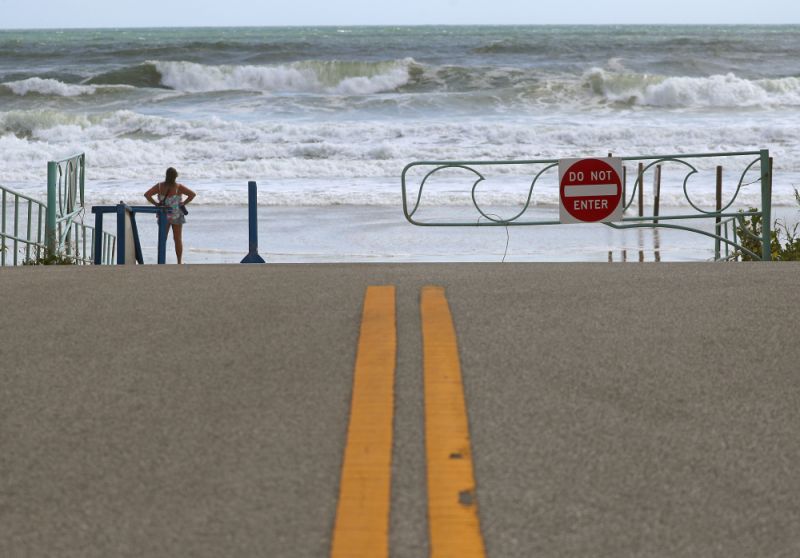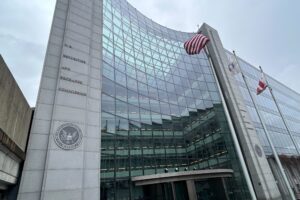
(Bloomberg) — Hurricane Dorian has slowed to a crawl over the Bahamas, and will likely inflict colossal damage to property and infrastructure there for most of the day before gradually turning to the northwest to begin a run up the U.S. East Coast.
Dorian was moving forward at just 1 mile per hour, according to an 8 a.m. advisory by the U.S. National Hurricane Center. It was packing sustained speeds of 165 mph and a storm surge that could top 23 feet. Located 30 miles (56 kilometers) north-northeast of Grand Bahama Island, Dorian has ripped off roofs, overturned cars and tore down power lines across the chain of islands, the Associated Press reported.
By late Monday evening and early Tuesday, the storm is expected to move “dangerously close” to the Florida shoreline, the hurricane center reported. But Dorian’s slow forward motion probably takes a direct hit on Florida’s coast off the table, said Adam Douty, a meteorologist with AccuWeather Inc. in State College, Pennsylvania
“It seems less likely that we will see a landfall in Florida,” Douty said by telephone. “The outer edge of the eye wall could brush Cape Canaveral.” Its current projected turn would also bring it close to the St. Lucie nuclear power station, home to two nuclear reactors owned by Nextera Energy Inc.’s subsidiary Florida Power & Light.
The high pressure system in the Atlantic that has been steering Dorian has collapsed and now meteorologists are waiting for low pressure in the central U.S. to come along and pick it up, said Ken Graham, hurricane center director, in a live Facebook briefing.
The current forecast keeps Dorian’s center off shore but “it doesn’t take much, a little wobble, a little wiggle and you have hurricane-force winds on shore,” Graham said. In addition to the high winds, coastal areas could get a 4-to-7 foot storm surge as Dorian slowly moves up the coast. Rain from Dorian has already reached Florida.
There is still a chance Dorian could make landfall in Florida, he said. In any case, the slow motion of the storm and its track up the East Coast means the U.S. won’t get relief for days. “We’re talking a hurricane for an entire week,” Graham said.
Dorian will cause at least $25 billion of insurance losses, according to analysts at UBS Group AG, the costliest of any natural disaster since 2017. Depending on whether it hits the eastern coast of Florida in the next few days, the storm could cost as much as $40 billion, they said
Roughly 100,000 of the Bahamas population of 370,000 live in areas that would be hit by the storm, said Kevin Peter Turnquest, the country’s deputy prime minister, adding in a response to queries that Abaco suffered “severe destruction of homes and infrastructure.”
The Bahamian government was preparing orders to allow donated relief supplies to move quickly to areas that need it most, local Eyewitness News reported on its website.
“This is probably the most sad and worst day of my life to address the Bahamian people,” Prime Minister Hubert Minnis said while crying during a press conference at the headquarters of the National Emergency Management Agency, The Nassau Guardian reported on Sunday. “This will put us through a test that we’ve never confronted before.”
Minnis said that homes in the Bahamas are built to withstand winds as strong as 150 miles per hour and the islands have never before faced a hurricane like Dorian, according to the paper. In some places that are facing the brunt of the storm, it wasn’t possible to tell the difference between the beginning of the street and the ocean, it cited him as saying.
Despite evacuation orders for those in vulnerable areas, many people hadn’t heeded the warning, he said.
Winds from then storm earlier were recorded at 185 mph, which tied the 1935 Labor Day hurricane, which crushed the Florida Keys, as the strongest storm ever to hit land anywhere in the Atlantic, said Maureen O’Leary, spokeswoman for the National Weather Service.
While the devastation mounts in the Bahamas, the threat to Florida and the U.S. East Coast remains uncertain despite the slowdown in forward motion.
A storm surge warning is in effect from Lantana, about 60 miles north of Miami, up to the Volusia/Brevard county line. A hurricane warning is in effect for the Jupiter Inlet, also up to Volusia/Brevard. While many people focus on winds, most hurricane deaths are caused by storm surge and drowning from flooding.
Meanwhile, airlines have canceled 1,070 flights within, into and out of the U.S. today. The most impacted airport is Fort Lauderdale International with 530, or about 73% of flights canceled.
Fluctuations in weather patterns across the U.S. and Atlantic mean Dorian could hit Florida or further up the coast in Georgia or the Carolinas later this week — or not make landfall at all. Mandatory evacuations have been ordered in parts of Florida, Georgia and South Carolina, including for the Mar-a-Lago club owned by Donald Trump, which the president often uses as a “Winter White House.”
“Life-threatening storm surge and dangerous hurricane-force winds are expected along portions of the Florida east coast through mid-week,” Lixion Avila, a senior hurricane specialist at the center wrote in an analysis. “Only a slight deviation to the left of the official forecast would bring the core of Dorian near or over the Florida east coast.”
To map assets in Hurricane Dorian’s path, click here
(Adds comments by hurricane center director starting in the fifth paragraph.)
–With assistance from Sharon Cho, Mark Chediak, David Baker, Will Wade, Todd Shields, Josh Wingrove, Alyza Sebenius, Michael Riley, Matthew Bristow, Andrew Janes, Bill Lehane and Will Hadfield.
To contact the reporters on this story: Brian K. Sullivan in Boston at [email protected];Jonathan Levin in Miami at [email protected]
To contact the editors responsible for this story: Tina Davis at [email protected], Reg Gale
<p class="canvas-atom canvas-text Mb(1.0em) Mb(0)–sm Mt(0.8em)–sm" type="text" content="For more articles like this, please visit us at bloomberg.com” data-reactid=”50″>For more articles like this, please visit us at bloomberg.com
©2019 Bloomberg L.P.



